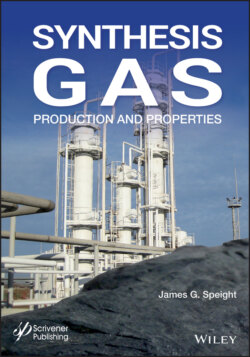Читать книгу Synthesis Gas - James Speight G., James G. Speight - Страница 63
2.6.2 Liquid Products
ОглавлениеThe production of liquid fuels from coal via gasification is often referred to as the indirect liquefaction of coal (Speight, 2013). In these processes, coal is not converted directly into liquid products but involves a two-stage conversion operation in which coal is first converted (by reaction with steam and oxygen) to produce a gaseous mixture that is composed primarily of carbon monoxide and hydrogen (synthesis gas). The gas stream is subsequently purified (to remove sulfur, nitrogen, and any particulate matter) after which it is catalytically converted to a mixture of liquid hydrocarbon products.
The synthesis of hydrocarbon derivatives from carbon monoxide and hydrogen (synthesis gas) (the Fischer-Tropsch synthesis) is a procedure for the indirect liquefaction of coal and other carbonaceous feedstocks (Starch et al., 1951; Batchelder, 1962; Dry, 1976; Anderson, 1984; Speight, 2011a, 2011b). This process is the only coal liquefaction scheme currently in use on a relatively large commercial scale; South Africa is currently using the Fischer-Tropsch process on a commercial scale in its SASOL complex (Singh, 1981).
Thus, coal is converted to gaseous products at temperatures in excess of 800oC (1470oF), and at moderate pressures, to produce synthesis gas:
The gasification may be attained by means of any one of several processes or even by gasification of coal in place (underground, or in situ, gasification of coal).
In practice, the Fischer-Tropsch reaction is carried out at temperatures of 200 to 350oC (390 to 660oF) and at pressures of 75 to 4000 psi. The hydrogen/carbon monoxide ratio is typically on the order of 2/2:1 or 2/5:1. Since up to three volumes of hydrogen may be required to achieve the next stage of the liquids production, the synthesis gas must then be converted by means of the water-gas shift reaction) to the desired level of hydrogen:
After this, the gaseous mix is purified and converted to a wide variety of hydrocarbon derivatives:
These reactions result primarily in low- and medium-boiling aliphatic compounds suitable for gasoline and diesel fuel.
